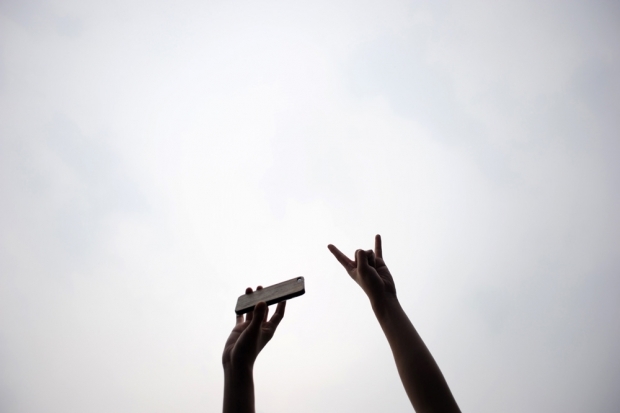China’s cyberspace is bursting with anticipation for the iPhone 6—never mind that it promises to cost more than most citizens make in a month. Apple, the U.S.-based company that designs and sells the iPhone, had scheduled a major announcement about its latest and greatest model for September 9; fulsome online chatter in China, which assembles the device, has the new phone hitting the Chinese market as early as September 19. Apple, whose two largest smartphone markets are China and the United States, is surely keen to preserve some element of surprise in order to draw attention to its official product launch. But with China being the source of the most alluring leaks about the soon-to-be-released iPhone 6, that’s proven quite complicated.
It seems, after all, like a marriage destined for failure: Apple (so notoriously harsh on product detail leaks that it once sent police to raid a tech blog editor’s house), and China (with its rumor-filled Internet, a generally loose interpretation of contracts such as non-disclosure agreements, and a massive number of people involved in the assembly and production of the tens of millions of iPhones sold every quarter). Yet despite U.S. tech and rumor blogs’ evident enthusiasm for leaks by anyone in China—Yahoo News declared Apple’s upcoming announcement “ruined” by one series of videos about the phone—Chinese themselves seem to be putting their trust in Apple. If anything, China’s robust black/gray market for iPhone fakes, as well as general mistrust of online rumors, has protected Apple’s brand by positioning the corporation as the sole trustworthy source of information about its own products.
That’s not to say iPhone rumors aren’t circulating. But the leaks most widely cited in the United States trace to two sources: a Weibo user who calls himself Ruiji and a Miaopai user whose online name approximately means “a long nap after lunch,” both of whom have shared videos of what they say are purloined iPhone 6s. (Weibo is a Twitter-like platform, and Miaopai is a short video platform akin to Vine.) Both have been met with significant skepticism domestically. Weibo users picked at the details of Ruiji’s video, in many cases expressing doubt that Ruiji’s phone was the real deal. In a response likely familiar to U.S. readers, one reader exhorted Ruiji, who shows his face along with the purported phone, to “wait for a letter from Apple’s lawyers.” Meanwhile, commenters on the Miaopai videos scoff that the phone is either a mockup or a so-called shanzhai.
That’s the most likely explanation, because shanzhai knockoffs of expensive iPhones are pervasive. In a widely cited September 6 article, a reporter for Legal Evening News describes a trip to one of many electronic superstores in Zhongguancun, a tech hub in northwest Beijing. At some stores there, so-called “yellow bulls” (slang for illegitimate middlemen) were charging as much as $4,550 for what were purported to be early-release iPhone 6s from Hong Kong. But when the reporter called one middleman’s bluff and asked to see the phone, the vendor claimed he would need three days to produce it. Outlets as staid as the official Xinhua news service have repackaged the report as hype about the phone’s market price, but more believable chatter pegs it at about $860.
Even that lower number is eye-wateringly high in a country whose 2013 per capita income was less than $570 per month, according to the World Bank. Gao Hao, an actor from northeastern China, captured this sentiment when he shared an image on Weibo of a water cooler bottle filled to the brim with coins. He wrote he had been “saving all this time” for an iPhone 6, wondering whether it will be enough.
Gao can surely afford a genuine Apple smartphone, but many others cannot. It’s become common practice among Chinese media outlets and netizens to preface comments about Apple’s big September 9 launch with phrases like, “Are you ready to sell your kidney?” and, “Two kidneys are not enough.” Weibo users have widely shared a diagram of a human body with purported “market prices” listed for each body part, pointing out that it would take two kidneys to purchase the new smartphone. It’s not just an expression: In a sensational 2011 case, a 17-year-old Chinese boy actually sold his kidney to buy an iPhone and iPad. That’s because Apple is essentially a sign of having arrived in China; gold-colored versions of the iPhone 5 are widely called “tuhao gold,” a sneering reference to the tuhao, or nouveau riche, who have seemed so eager to flaunt them. And Chinese buyers have shown strong interest in preorders for the iPhone 6.
But no trend lasts forever, and discussing the prices foreign firms charge for their wares in China has become a politicized exercise of late. State broadcaster China Central Television (CCTV) lambasted Starbucks in October 2013 for charging higher prices in its Chinese stores than in other countries. In August, Chinese regulators began targeting foreign car manufacturers such as Audi and Chrysler for monopolistic behavior, citing high prices on vehicles and spare parts. In May 2013, amid a budding government crackdown on government corruption and conspicuous consumption, Chinese First Lady Peng Liyuan even made a high-profile switch from an iPhone to the modestly-priced Chinese-made ZTE Nubia. With a new spate of lower-priced Chinese-made smartphones like Xiaomi's $285 Mi 3 challenging Apple’s popularity, the last thing the U.S. tech firm needs to worry about is leaks—particularly when many Chinese don’t believe them anyway.




